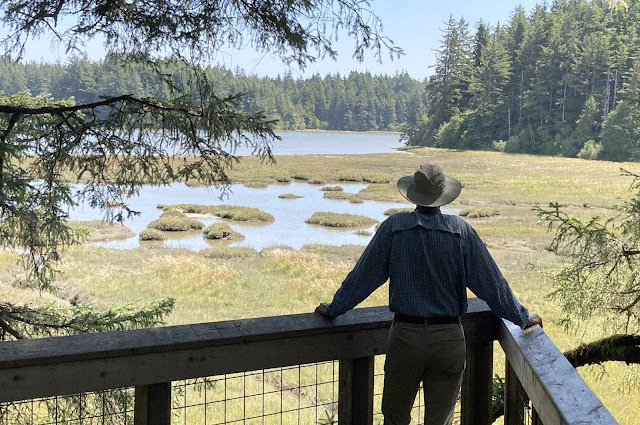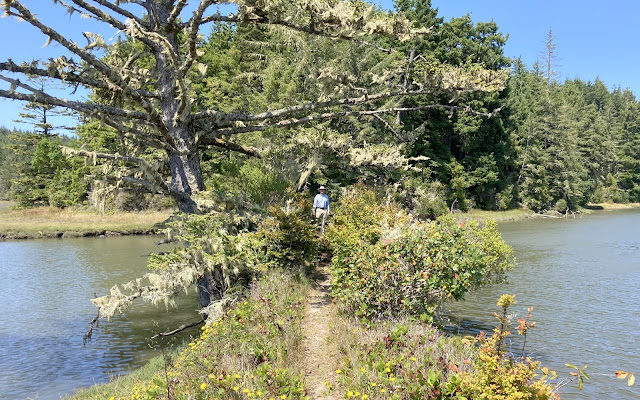We know that we were just on the beach last night, and here we are again this morning! We set the alarm clock so that we could be back for this special low tide here at Bandon Beach.
We just saw Face Rock as the sun was setting at 7 p.m. and now we are back for another Face Rock picture at 7 a.m.
While some of these sea stacks were out of the water last night, more rocks are showing this morning because this is a negative tide--one of the lowest of the season.
That exposes sea stars and other sea creatures that don't usually get uncovered.
Because so many of these lovely sea stars were uncovered this morning, Denisa took way too many pictures!
While we used to think that sea stars always looked like a symmetrical 5-pointed star, we now know that posture is only seen with a dead or dying sea star like this one found on the sand.
A healthy sea star should be clinging to the side of a rock, in anything but perfectly symmetrical lines.
Most of these guys look healthy, and bigger than you might think.
Tide pooling and searching for sea stars is one of Denisa's favorite beach activities!
We read that sea stars are able to survive these periods out of the water because they have the ability to suck up extra ocean water during high tide.
They survive these periods without water by folding their tentacles inside and closing up.
Denisa could wade around these seldom-uncovered rocks for hours. But this negative low tide will last less than an hour.
Then the water will start creeping back in to recover those secret sea creatures that we were blessed to see this morning.
When the waves start creeping in, it sometimes takes some fast maneuvers to stay dry.
We also found some feathery wildlife on the beach this morning.
This oystercatcher with its bright red beak and eye let us get close enough for a picture.
The negative tide also allowed us to walk closer than usual to Face Rock.
From this closer view, we could see that the nose and lips are actually nesting areas for the common murres.
On the back-side slope of Face Rock, a colony of cormorants have taken up residence.
As the tide was coming in, we made our way back up the bluff overlooking Bandon Beach. From here we can see the bigger picture of these beautiful sea stacks and the hidden treasures they unveil during a negative tide.
Those random rocks on the beach seem much bigger when we include the random beach walkers this morning.
After six years of traveling, Bandon Beach still continues to be one of our favorite places!
Since we were up so early this morning, we have plenty of time to do some exploring outside of our favorite town of Bandon. So we are heading north up the back roads along the coast for a hike at the National Estuary Research Reserve. Estuary is a fancy term for where the fresh water river meets the salt water ocean. With all that water meeting, the plants are lush and green on this trail.
At times this 3.4-mile loop trail was completely shaded by overhead trees and vines.
Then it opened up for a view of the south slough where the briny water was mixing.
We walked out on a spit of land with Winchester Creek on both sides. We are really enjoying the blue skies and cool summer temperatures here today!
As we travel further north, we come to the tiny town of Charleston, Oregon, where we can see a series of state parks along this section of the coast. Our first stop is at Cape Arago for views of the waves crashing along this rocky shore line.
As soon as we got out of the pickup, we could hear some familiar sounds from the beach. We headed down a trail toward the water, and got a good view of the source of those sounds.
Sea lions are noisy, as they lift their noses to the air and call out.
We could watch these guys for hours, but the best viewpoint was on the edge of a cliff, where the cool wind was blowing hard. We hate to complain about being cold during the hottest time of the summer, but Denisa was chilly even though she had on her coat and gloves!
It was fun to watch them waddle to the rock's edge, and then let the waves sweep them into the water.
We also enjoyed watching all the effort it took to get back up that steep rock wall . . .
for a well-deserved nap.
While it was easy to watch the groups closest to us, we could also zoom in to see much bigger groups on rocks further from the shore. The islands just off this shore are national marine wildlife reserves, and they are safe and happy here.
We struck up a conversation with a nice retired couple spending their summer on the coast volunteering with Oregon state parks. Even though this isn't their park and it was their day off, they set up their viewing scope so others could get close up views of those distant animals.
An information board explained that we could be seeing California sea lions, Stellar sea lions, harbor seals, or elephant seals, and explained the differences.
After taking way too many pictures, we finally left the noisy sea lions, and took the steep hike down to Cape Arago's South Cove--one of the secluded beaches in this state park. Mark climbed up on one of the rocks at the water's edge. Denisa really wanted a picture with a wave crashing onto the rock. When she told Mark that she was waiting for a wave, he waved at her. You got to love it when you live with a man with a sense of humor.
This beach also had an elaborate shelter made of driftwood and sea rocks. Just standing inside made us feel a little like the Swiss Family Robinson on some remote island in the Pacific.
A short drive north, brought us to the viewpoint for Simpson Reef. From here we got another view of a distant rock . . .
with more seals and sea lions. It's wall to wall flippers on that rock.
Birds are probably protected in this area as well, as Denisa snapped a picture of this pair.
Our next state park stop is the Shore Acres Gardens. This is the only Oregon state park we have found with an admission charge, but Mark paid it because he knows that Denisa loves flowers.
The rose gardens filled the biggest part of the park, but we could tell that most of them were getting to the end of their blooming season.
But we thought the dahlias were the stars of the show right now. Some of these blooms are the size of a dinner plate!
These petite dahlias were a beautiful color and it was just amazing to see the detail of their petals. We've wondered into lots of God's animal and plant wonders today!
The rest of the pictures were of random flowers at Shore Acres, that were just too pretty not to photograph.
The Simpson Family used to live here, and that was their flower garden at one time. They also had a private beach with their own cove on the Pacific. When we visited here four years ago we walked down on that beach. But we've had a long day with lots of beach walking already, so we were content with a picture from the top.
In fact, Mark didn't even get out of the pickup when Denisa walked down to take a picture of the Yoakum Point Lighthouse here at Sunset Beach.
It is remote enough that this is the best picture we could get from the state park.





















































